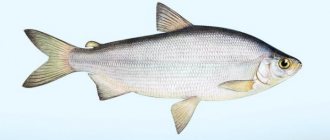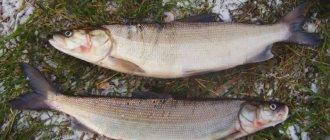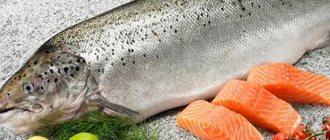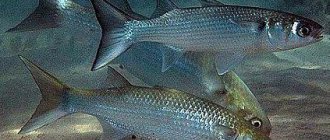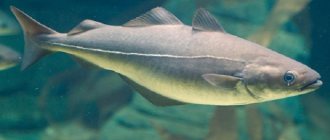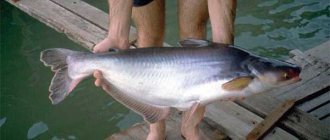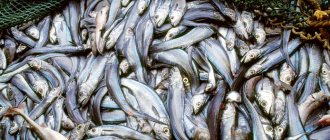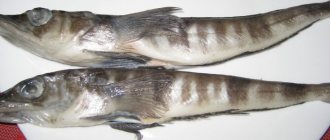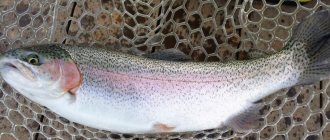Description of the predator
The fish belongs to the ray-finned species from the order Perciformes. A large predator frightens with its threatening appearance and strength.
Another name for the predator is swordtail . An individual of this species grows up to three meters in length, but some reach 4.5 m. The approximate weight of one fish is 450 kg. The world record is a fish weighing 537 kg, caught on the shores of Chile.
The life expectancy of the predator is 10 years. Females are larger than males and live 5 years longer.
The swordfish looks like a sharp, dangerous weapon. Thanks to its threatening appearance, it received the appropriate name. The bone formations of the upper jaw, similar to a sword blade, reach 2 m in length. The flat growth is frightening in appearance. There is an opinion that with the help of sharp weapons on the body, the swordtail stuns other predators, but does not suffer itself.
The elongated snout, most of which extends behind the eyes, is the swordfish’s main weapon. Predators pierce 3 cm thick metal without any problems. The impact force is over 4 tons. If the fish cannot get back out of the side, it will die.
Swordfish have no scales, but their body is well developed and takes on a streamlined shape. The fish has a tail in the shape of a moon. There are no fins on the belly, but they are present on the back, chest and sides. On the back there is a large front fin, starting from the back of the head. The rear one is located near the tail. This structure allows the swordfish to reach speeds of up to 130 km/h, which makes it faster than a cheetah.
The layers of fat act as a shock-absorbing spring. Thanks to this, an individual, when hitting an obstacle at a speed of more than 100 km/h, remains unharmed or suffers minor injuries.
The body of the sword fish is well developed and lacks scales.
The body of the individual is brown with a dark blue tint. The sides are cast in a metallic shade, and the belly is cast in a silvery tint. Blue eyes stand out against the general background. Young animals have stripes on their bodies that are lost over time.
Swordfish do not maintain their body temperature above water, but they have some peculiarity - they have a blood-warming organ around the eye . Blood flows to the brain stem and eyes, allowing fish to remain undetected at great depths in the ocean.
The fry grow teeth, but over time they lose them. Fish that do not reach 1 m in length have spines on their body. The gill muscles are like a mesh.
Swordfish: photo, description
Swordfish is a very large marine predator that belongs to the order Perciformes and is the only representative of the Swordfish family.
These giants grow up to four meters in length and weigh more than five hundred kilograms; there are some individuals with a body length of more than 4.5 meters and a weight of about 650 kilograms. The raptor's sword is an elongated snout formed by the premaxillary bones in the shape of a sword. The mouth is located below; only young swordtails have teeth. This fish has no scales, its back is dark blue, its sides are gray and blue, and its belly is silver.
Description[ | ]
Skeleton of a swordfish in the National Museum of Natural History (Washington)
The body is powerful, elongated, cylindrical in cross section, tapering towards the caudal peduncle. The so-called “sword” (or “spear”), which is a greatly elongated upper jaw, is formed by the premaxillary and nasal bones, flattened in the dorsoventral direction. The mouth is lower, not retractable; There are no teeth on the jaws. The eyes are big. The gill membranes are not attached to the interbranchial space. Gill rakers are absent. The gills on each gill arch are modified plates connected into one mesh plate [7]. There is a swim bladder.
Two dorsal fins with a very large gap between their bases. The first dorsal fin has a short base, starts above the back of the head, and contains 34-49 soft rays. The second dorsal fin is much smaller than the first, shifted far towards the caudal peduncle, and consists of 3-6 soft rays. The two anal fins also lack hard rays; the first anal fin is much larger than the second, with 12-16 rays. The second anal fin has 3-4 rays. The pectoral fins are sickle-shaped with 16-8 rays, located low on the body. Pelvic fins and their belts are absent. The anus is located near the beginning of the first anal fin. The caudal peduncle is flattened dorsoventrally, there are powerful single carinae on each side, and one deep notch on the ventral and dorsal sides. The caudal fin is strongly notched and month-shaped. There is no lateral line. There are 26 vertebrae (15-16 in the trunk and 10-11 in the caudal spine)[8].
Swordfish
The back and upper body are dark brown, gradually changing to light brown on the belly. The membranes of all fins are brown or dark brown in color of varying intensity, in the first dorsal they are the darkest. Young fish have transverse stripes, which disappear as the fish grows. Larvae and young individuals of swordfish differ significantly from adult individuals in morphology, scale cover, etc. Changes in external appearance occur gradually and are completed only in individuals about 1 m long.
The length can reach 4.55 m, but is usually about 3 m. The maximum weight of swordfish is recorded at 650 kg [9].
Human interaction[ | ]
World catches of swordfish in 1950–2009, tons [32]
Swordfish are a valuable trophy of sport fishing - fishing by trolling.
There are cases where swordfish have pierced the sides of boats, but such incidents are an accident caused by the high speed of the swordfish and the inability to quickly change the trajectory of movement. Sometimes, having stuck into the side of the ship, the swordfish could not pull out its sword and died. In June 1967, a swordfish attacked the manned bathyscaphe Alvin off the coast of Florida at the very bottom at a depth of 610 m. The Sword got stuck in the outer shell of the bathyscaphe, and in this state the fish was raised to the surface [33].
No attacks on humans were recorded until May 2015, when a swordfish in Hawaii attacked fishing boat skipper Rensi Llanes, who harpooned it. The sword pierced the chest and the man died[34].
fishing
Valuable commercial fish. Specialized fisheries are conducted primarily with pelagic longlines. Fishing is carried out in more than 30 countries, including Japan, the USA, Italy, Spain, Canada, Korea, China, the Philippines, and Mexico. The largest catches are observed in the northwestern and central-eastern parts of the Pacific Ocean, the western Indian Ocean, the Mediterranean Sea and the southwestern Atlantic[8]. The historical maximum of global catches was reached in 2014 - about 127 thousand tons[35]. They are caught as bycatch in pelagic trawls. Illegal driftnet fishing has been reported in some areas[36].
Two swordfish fishing boats in the port of Bagnara Calabra, Italy
World swordfish catches
[35]
| Year | 2010 | 2011 | 2012 | 2013 | 2014 | 2015 | 2016 |
| World catches, thousand tons | 101,7 | 110,1 | 116,2 | 115,6 | 126,9 | 125,8 | 125,6 |
Swordfish auction at a market in Vigo, Spain
In 2010, Greenpeace added swordfish to its seafood red list, a list of species sold in supermarkets around the world that are at high risk of overfishing.[37]
eating
The meat is without small bones, very tasty, and has virtually no pungent odor inherent in fish.
According to the US Food and Drug Administration for 1990–2012. Mercury levels in the body of swordfish can exceed safe levels set by the US Environmental Protection Agency for people who regularly eat fish, reaching 3.2 ppm. Therefore, it is not recommended for children and pregnant women to eat swordfish meat[38].
What does a swordfish look like?
As a rule, an individual of this species grows to about 3 meters, but some swordtails grow up to 4.5 meters in length. One fish weighs on average about 400 kilograms (the largest of the caught individuals weighed 537 kilograms).
Females are usually larger than males and have a longer lifespan. Swordtails live about 10 years.
Externally, the predator looks like a sharp, deadly weapon, which is how the species got its exact name. The bones of the upper jaw, which resemble a sword blade, usually reach a length of 1–1.5 meters.
An oblong snout with maxillary bones with a good layer of fat is the main weapon of swordfishes. They can easily pierce metal 2.5 centimeters thick or a board 40 centimeters thick without receiving serious injuries.
However, if the “sword” gets firmly stuck in the side, the predator will not be able to get out and will die. The striking force of swordfish is more than 4 tons.
Swordtails have a wide mouth that extends behind the eyes. Young fish grow teeth, but in adulthood they lose them. Very small individuals, when they are still less than 1 meter in length, have spines on their body. The gill filaments of swordfish resemble a plate in the form of a mesh.
These fish do not have scales, but they have a streamlined, highly developed body and a crescent-shaped tail. This structure allows swordtails to reach speeds of up to 130 kilometers per hour, which makes them faster than the fastest cheetahs.
In color, individuals of the species in question are usually brown, but are cast in dark blue. The sides have bluish metallic tones, and the belly shimmers with silvery shades. The eyes are bright blue. Young predators have stripes on their bodies, but they disappear with age.
Swordfish do not have pelvic fins, but have dorsal, pectoral and lateral fins. However, they are not continuous and are divided into 2 parts. The front fin on the back is high, black, triangular in shape and starts from the back of the head. And the rear dorsal fin is located near the tail. The remaining fins are brownish in color with black lines.
Most fish maintain their body temperature above the temperature of the water that surrounds them, but swordfish do not have this ability. But they have an organ that heats the blood 15 degrees higher than the temperature in the environment. This blood flows to the brain and eyes, which allows swordfish to remain invisible and at the same time find victims at great depths.
Habitats and food
Swordfish lives in warm climates. It prefers tropical and temperate latitudes, so it can be found in the depths of the Pacific, Indian and Atlantic oceans. Favorable water temperature:
- for adults - 18-22 °C;
- for fry and caviar - 24 °C.
During the warm summer period, the fish swims to cold waters, and when the temperature drops, they return back. Individuals do not swim to the shores. Swordfish live at depths of up to 800 m, but can descend to 2800 m. Predators do not group in schools, preferring solitude. They maintain a distance of 10-100 m from each other. The fish often basks in the water under the rays of the sun and ventilates the dorsal fin.
Swordfish can dive to depths of up to 2800 meters
Food for swordtail:
- tuna;
- mackerel;
- herring;
- squid;
- crustaceans;
Swordfish is found where the climate is more favorable. She hunts on the surface of the water for small individuals, and feasts on large inhabitants of great depths, for example, sharks.
